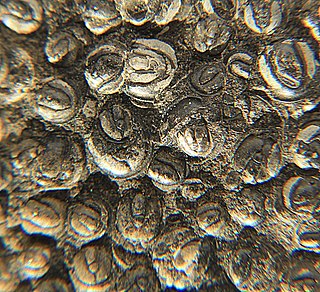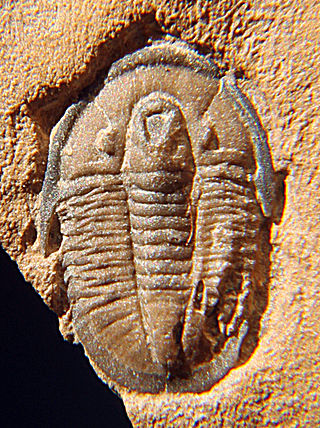
Agnostus is a genus of agnostid trilobites, belonging to the family Agnostidae, that lived during the late Middle Cambrian – early Upper Cambrian. It is the type genus of the family Agnostidae and is subdivided into two subgenera, Agnostus and Homagnostus.

Dicerodiscus is an extinct genus from a well-known class of fossil marine arthropods, the trilobites. It lived during the early part of the Botomian stage, in China. Four species have been assigned to it. Dicerodiscus is unique for an eodiscoid in having conspicuous and curved spines that are attached anteriorly, and at their base are directed outward perpendicular to the midline, before gradually bending further backwards.

Meteoraspis is an extinct genus of ptychopariid trilobites of the family Tricrepicephalidae. The various species lived from 501 to 490 million years ago during the Dresbachian faunal stage of the late Cambrian Period. Fossils of Meteoraspis are characteristic of Late Cambrian strata in North America, though they are found in Late Cambrian strata elsewhere in the world, such as M. nevensis from Victoria Land, Antarctica.
Acadagnostus is a genus of trilobite from the Middle Cambrian, with 7 species currently recognized. The type species A. acadicus has the widest distribution known from any peronopsid and has been found in North America, Greenland, England, Western Europe, Eastern Europe, Central Asia, the Altai Mountains, the Siberian shield, China, and Australia.
Acmarhachis is a genus of trilobite in the order Agnostida, which lived in what are now Australia, Canada, China (Anhui), Kazakhstan, Russia (Kharaulakh), and the US. It was described by Resser in 1938, and the type species is Acmarhachis typicalis.
Lotagnostus is a genus of very small trilobites in the order Agnostida, which lived on the outer continental shelves worldwide, during the late Upper Cambrian. It was described by Whitehouse in 1936, and the type species is Lotagnostus trisectus, which was originally described as a species of Agnostus by Salter in 1864.

Phalagnostus is a genus of small trilobites, in the order Agnostida. It lived during the Middle Cambrian, in what are now Canada, China, the Czech Republic, Denmark, England, France, the Russian Federation, Wales, Sweden, and possibly the United States (Vermont). The headshield is almost entirely effaced and wider than the tailshield. The pygidium is also very effaced, but the ovate pygidial axis is well defined and a border furrow is also present.

Aaveqaspis is a genus of small marine arthropods of unclear affiliation, that lived during the early Cambrian period. Fossil remains of Aaveqaspis were collected from the Lower Cambrian Sirius Passet fossil-Lagerstätte of North Greenland. Aaveqaspis looks like a soft eyeless trilobite with a weakly defined axis, a headshield with stubby genal spines, 5 thorax segments also ending in stubby genal spines, and a tailshield (pygidium) with a pair of massive tusk-like spines, and two smaller spines near the end of the axis. The only species presently known is A. inesoni.

Marocconus is an extinct genus from a well-known class of fossil marine arthropods, the trilobites. It is still debated if it lived at the very end of the Lower Cambrian or at the very beginning of the Middle Cambrian. Marocconus notabilis is the only known species in this genus.

Galbagnostus is an extinct genus of agnostid trilobite. It lived during the Lower and Middle Ordovician.

Sphaeragnostus is an extinct genus from a well-known class of fossil marine arthropods, the trilobites. It can be recognized by having two thorax segments, a totally effaced headshield, while the tailshield although effaced, has a clear furrow parallel to its border, and a short, convex, subcircular axis. It lived during the Ordovician.

Thoracocare is a minute to very small trilobite, that lived during part of the Middle Cambrian in what are today the states of Idaho, Nevada and Utah. It is the only trilobite known with just two thorax segments outside most members of the Agnostida order. It can be distinguished from Agnostida by the very wide subquadrate glabella, parallel-side or widening forward in the largest specimen, with the full front side touching the border. Two species are known, one, T. idahoensis, only from pygidia.

Delgadella is a diminutive trilobite that lived during the late Lower Cambrian and has been found in Russia, Mongolia, Spain, Italy (Sardinia), Portugal, Morocco and Canada (Newfoundland). It can be recognized by its strongly effaced headshield and tailshield, with narrow but distinct furrows and borders along its margins, and three thorax segments.

Geragnostus is a genus of very small agnostid trilobites whose fossils are found Ordovician-aged marine strata from Eurasia, North America and Argentina.

Eodiscidae is a family of agnostid trilobites that lived during the final Lower Cambrian and the Middle Cambrian. They are small or very small, and have a thorax of two or three segments. Eodiscidae includes nine genera.
The Hebediscidae Kobayashi, 1944, are a family of trilobites belonging to the order Agnostida that lived during the Lower Cambrian. They are small or very small, and have a thorax of two or three segments. The Hebediscidae include five genera.
The Calodiscidae Kobayashi, 1943 [nom. transl. Öpik, 1975 ex Calodiscinae Kobayashi, 1943] are a family of trilobites belonging to the order Agnostida that lived during the Lower Cambrian. They are small or very small, and have a thorax of two or three segments. The Calodiscidae includes five genera.

Cedaria is a small, rather flat trilobite with an oval outline, a headshield and tailshield of approximately the same size, 7 articulating segments in the middle part of the body and spines at the back edges of the headshield that reach halflength of the body. Cedaria lived during the early part of the Upper Cambrian (Dresbachian), and is especially abundant in the Weeks Formation.

Tricrepicephalus is an extinct genus of ptychopariid trilobites of the family Tricrepicephalidae with species of average size. Its species lived from 501 to 490 million years ago during the Dresbachian faunal stage of the late Cambrian Period. Fossils of Tricrepicephalus are widespread in Late Cambrian deposits in North America, but is also known from one location in South-America. Tricrepicephalus has an inverted egg-shaped exoskeleton, with three characteristic pits in the fold that parallels the margin of the headshield just in front of the central raised area. The articulating middle part of the body has 12 segments and the tailshield carries two long, tubular, curved pygidial spines that are reminiscent of earwig's pincers that rise backwards from the plain of the body at approximately 30°.
Anabaraspis is a genus of redlichiid trilobite. A. splendens occurs in the uppermost Lower Cambrian and lowest Middle Cambrian of Russia. In Anabaraspis there is a long area in front of the glabella which is not differentiated in a border and a preglabellar field. This is a unique character in the family Paradoxididae. The frontal lobe of the central raised area of the headshield is slightly pointed, rather than rounded or truncate, a character shared with Plutonides, though, in Plutonides it hangs over the short anterior border.














